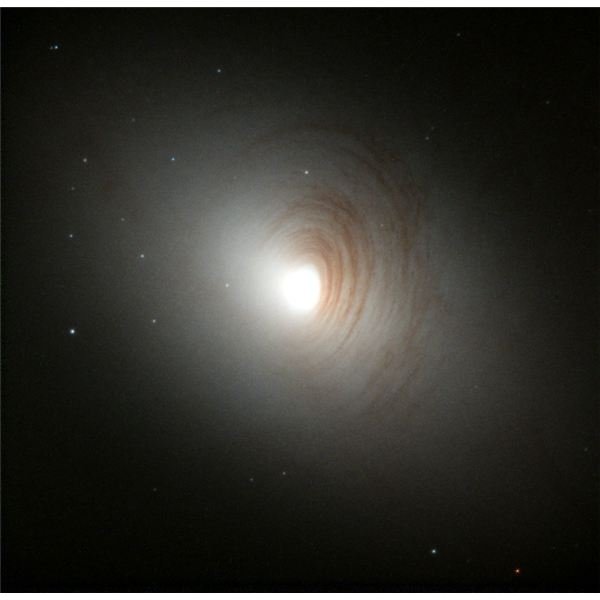In all of the universe, the massive amount of galaxies can be broken down into four basic classification categories. There are spiral galaxies, elliptical galaxies, lenticular galaxies, and irregular galaxies. These names mainly refer to the shapes of the galaxies, but there are other qualities, including the types of stars that make up each galaxy, that also contribute to classification.
Spiral Galaxies
Spiral galaxies are like our Milky Way Galaxy. They are a flattened disc shaped with spiral arms, and a blackhole at the center. The majority of the stars in a spiral galaxy are within this disc component. These stars are of all ages, and because of the high concentration of gas clouds in the disc, there is also ongoing star formation. In addition to the disc component, there is a spheroidal component to spiral galaxies. This includes the bulge at the center of the galaxy, and the halo, which surrounds the flattened disc of the galaxy. In the halo, stars are generally older, there are few gas clouds, little star formation, and star have more random orbits. Spiral galaxies are generally found in groups of a few dozen other galaxies.
 |
| Diagram of the Milky Way, a spiral galaxy |
In addition, there is a subgroup of spiral galaxies called barred spiral galaxies. The only difference between these and regular spiral galaxies, is that barred spirals have a bar of stars that goes across the bulge.
 |
| Spiral Galaxy |
 |
| Barred Spiral Galaxy |
Elliptical Galaxies
Elliptical galaxies are the most common type of galaxy in the universe. Unlike spiral galaxies, elliptical galaxies have no disc component, they are not flattened. Instead they are spheroidal in shape, with some being perfectly round, while others are more elongated and closer to a disc shaped. The other difference between elliptical galaxies and spiral galaxies is that elliptical galaxies are not star forming. There is little dust and gas, and they are made up of all older cooler stars. Consequently, they are red in color, because cooler stars give off red light, whereas hotter stars give of blue light. The final difference between elliptical galaxies and spiral galaxies, is that elliptical galaxies are found in huge dense clusters of 100 to 1,000 galaxies.
 |
| Elliptical Galaxy
Lenticular Galaxies
The next type of galaxy is the lenticular galaxy. Lenticulars are a middle ground between spiral and elliptical galaxies. They have a disk shape like a spiral galaxy, but like an elliptical galaxy, they have much less dust and gas. As a result, there is not much ongoing star formation in these galaxies.
|
 |
| Lenticular Galaxy |
Irregular Galaxies
The final type of galaxy is the irregular galaxy, which does not fit into any one of the previous categories. Like its name suggests, irregular galaxies are irregular in shape, and are weird and distorted. Irregular galaxies were very common in the early universe, are star forming, and are usually not red in color, meaning there are not as many old stars in these galaxies.
Examples of irregular galaxies
Hubble’s Tuning Fork Diagram
The final component of galaxy classification is Hubble’s tuning fork diagram, which is a way to organize the galaxy types, excluding irregular galaxies. Below is the tuning fork diagram:
The diagram starts with elliptical galaxies, which are are denoted by the letter “E.” The diagram starts with galaxies classified as “E0,” which are the most perfectly spherical elliptical galaxies. Moving from left to right, the ellipticals are classified up to “E9.” Elliptical galaxies determined to be “E9” are the most elongated and disc like of the ellipticals.
After the elliptical, the diagram splits. At this split are the lenticular galaxies, which are classified as “SO”. The top part of the fork are the normal spiral galaxies, which are classified as “S.” Furthest left are the “Sa” spirals, which have tightly wrapped arms. Moving left to right, the arms are more and more loosely wrapped. “Sb” are intermediate, and Sc are the loosest wrapped arms. The bottom part of the diagram contains the barred spiral galaxies, which are classified as “SB.” From left to right, barred spirals are classified in the same way as the normal spirals. “SBa” galaxies have the most tightly wrapped arms, “SBb” are intermediate, and “SBc” galaxies have the most loosely wrapped arms.
So why is galaxy classification important? Historically it was done to try to explain galaxy evolution. It was theorized that galaxies began life as ellipticals, and progressed along the tuning fork diagram and evolved into lenticulars, and finally into spirals. This, however, was proven to be wrong, but we are left with the legacy of this theory, as elliptical and lenticular galaxies are called "early type" and spirals are called "late type."
So why is galaxy classification important? Historically it was done to try to explain galaxy evolution. It was theorized that galaxies began life as ellipticals, and progressed along the tuning fork diagram and evolved into lenticulars, and finally into spirals. This, however, was proven to be wrong, but we are left with the legacy of this theory, as elliptical and lenticular galaxies are called "early type" and spirals are called "late type."





No comments:
Post a Comment